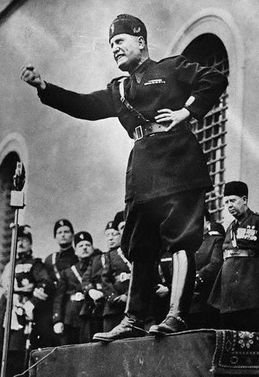What is Fascism in Simple Terms?

Introduction to Fascism
Fascism is a term that evokes strong reactions and images of totalitarian regimes, oppressive dictatorships, and brutal wars. To understand what fascism is in simple terms, it’s essential to break down its key characteristics, historical context, and enduring impact on society. This article aims to explain fascism in an accessible way, covering its definition, traits, history, and modern relevance.
Simple Definition of Fascism
At its core, fascism is an authoritarian and nationalistic political ideology that seeks to create a centralized, autocratic government led by a dictatorial leader. It often includes stringent socioeconomic controls, suppression of opposition through terror and censorship, and policies of belligerent nationalism and racism. Fascism stands in stark contrast to liberal democracy, socialism, and communism, aiming to create a society where the state exerts total control over many aspects of life.

Key Characteristics of Fascism
- Authoritarian Leadership: Fascist regimes are typically characterized by a single leader who wields absolute power. This leader is often charismatic and portrayed as the savior of the nation. Examples include Benito Mussolini in Italy and Adolf Hitler in Nazi Germany.
- Extreme Nationalism: Fascism promotes the supremacy of the nation or race over individuals. This form of nationalism often manifests in aggressive foreign policies and xenophobia, fostering a sense of superiority and unity among the populace.
- Suppression of Opposition: Fascist governments maintain control through violence, censorship, and propaganda, suppressing any form of political dissent. This ensures that only the regime’s ideology is propagated, and any opposition is swiftly dealt with.
- Regimentation of Society: In a fascist state, the government exerts control over many aspects of life, including the economy, education, and the media. This regimentation is aimed at enforcing conformity and mobilizing society for nationalistic goals.
- Militarism: Fascism often glorifies military strength and aims to build a powerful, aggressive military. This militarism is used to enforce the regime’s policies both domestically and internationally.
History and Origins of Fascism
Fascism originated in Europe during the early 20th century, amidst the political and economic turmoil following World War I. The term “fascism” comes from the Italian word “fascio,” meaning a bundle or group, symbolizing strength through unity. Benito Mussolini, who ruled Italy from 1922 to 1943, is often credited with founding the first fascist regime.

Early Fascism in Italy
Mussolini’s fascism was rooted in the desire to restore Italy’s former glory and address the perceived failures of liberal democracy. His regime emphasized aggressive nationalism, militarism, and the suppression of political opponents. The fascist state sought to control all aspects of Italian life, from the economy to culture, and used propaganda and terror to maintain its grip on power.
Nazi Germany: The Most Infamous Fascist Regime
In Germany, Adolf Hitler’s Nazi Party rose to power in 1933, establishing one of the most notorious fascist regimes in history. The Nazi regime was characterized by extreme nationalism, anti-Semitism, and the pursuit of Aryan racial purity. Hitler’s government implemented policies that led to World War II and the Holocaust, a genocide that resulted in the deaths of six million Jews and millions of others deemed undesirable by the Nazis.

Fascism vs. Democracy
Fascism fundamentally opposes democratic principles. While democracy promotes individual freedoms, political pluralism, and government accountability, fascism suppresses individual rights and dissent, centralizing power in a single leader or party. Fascist regimes reject democratic elections and instead rely on propaganda and force to maintain control.
In a democratic system, power is distributed among various branches of government, and leaders are elected by the people. In contrast, a fascist regime concentrates power in the hands of a dictator or a small ruling elite, eliminating checks and balances and often employing violence to maintain order.
Key Traits of Fascism
- Cult of Leadership: Fascist regimes often revolve around a charismatic leader who is portrayed as the embodiment of the nation’s values and the savior from its perceived threats. This leader is typically granted extraordinary powers and is idolized by the populace.
- Mass Mobilization: Fascist movements seek to engage the masses through rallies, propaganda, and youth organizations. This mass mobilization aims to create a unified, energized populace ready to support the regime’s goals.
- Ideological Purity: Fascism emphasizes ideological purity, promoting the idea that only those who adhere to the regime’s beliefs are true members of the nation. This often leads to the persecution of minorities and political dissidents.
- Scapegoating and Persecution: Fascist regimes frequently target specific groups as scapegoats for societal problems, leading to widespread persecution and violence. This tactic helps to unify the majority by creating a common enemy and diverting attention from the regime’s failings.

Examples of Fascist Governments
- Italy under Mussolini: Mussolini’s Italy was the first fascist state, characterized by a strong central government, suppression of opposition, and aggressive foreign policy. Mussolini’s regime sought to revive the Roman Empire and implemented policies that promoted Italian nationalism and militarism.
- Nazi Germany: Hitler’s regime is the most notorious example of fascism, marked by extreme nationalism, anti-Semitism, and the pursuit of Aryan racial purity. The Nazi government implemented a totalitarian state, controlled the media, and used propaganda to maintain its power. The regime’s aggressive expansionism led to World War II and the Holocaust.
- Francoist Spain: Francisco Franco’s dictatorship in Spain (1939-1975) exhibited many fascist characteristics, including authoritarian rule, nationalism, and repression of opposition. Franco’s regime maintained strict control over Spanish society and used propaganda and censorship to suppress dissent.
Fascism in Today’s World
While traditional fascism is largely considered a relic of the past, some elements and ideologies reminiscent of fascism persist in various forms today. Modern far-right movements in different parts of the world sometimes exhibit traits such as extreme nationalism, authoritarianism, and xenophobia. It is crucial to remain vigilant and recognize these traits to prevent the resurgence of fascist ideologies.

Impact of Fascism
The impact of fascism has been profound and devastating. Fascist regimes have led to wars, genocides, and the suppression of human rights. The lessons from the history of fascism underscore the importance of safeguarding democratic values and promoting tolerance and pluralism in society.
Anti-Fascism
In response to the threat posed by fascism, various anti-fascist movements have emerged over the years. These movements advocate for democratic principles, human rights, and social justice, opposing any form of authoritarianism and extremism. Understanding the importance of anti-fascism helps in recognizing and combating the dangers of fascist ideologies.
Fascism Symbols
Fascism is often associated with specific symbols, such as the fasces (a bundle of rods with an axe, symbolizing unity and authority) in Italy and the swastika in Nazi Germany. These symbols have become emblematic of the regimes that used them and are often banned or heavily restricted due to their association with hate and violence.
Fascism and Nationalism
Nationalism is a central component of fascism. Fascist regimes promote an intense form of nationalism that emphasizes the superiority of the nation or race and often justifies aggressive policies and the persecution of minorities. Understanding the relationship between fascism and nationalism is key to recognizing the dangers posed by extremist nationalist movements.
Fascism and Totalitarianism
Fascism is often linked with totalitarianism, a system in which the state seeks to control every aspect of public and private life. Both fascism and totalitarianism involve centralized control, suppression of dissent, and propaganda. However, while all fascist regimes are totalitarian, not all totalitarian regimes are fascist. For instance, the Soviet Union under Stalin was a totalitarian state but not a fascist one.
The Role of Propaganda in Fascism
Propaganda plays a crucial role in fascist regimes. By controlling the media and disseminating biased information, fascist leaders can manipulate public perception and maintain their power. Propaganda often glorifies the leader, promotes nationalistic values, and vilifies perceived enemies of the state.
Fascism’s Economic Policies
Fascist economic policies typically involve a combination of state intervention and private enterprise. While the state exerts control over critical industries and resources, private businesses are often allowed to operate within the framework set by the government. This approach aims to create a self-sufficient economy that serves the national interest.
Fascism and Militarism
Militarism is a hallmark of fascism. Fascist regimes prioritize military strength and often pursue aggressive expansionist policies. The glorification of the military and the emphasis on martial values help to foster a sense of unity and purpose among the populace.
Fascism’s Cultural Impact
Fascism also seeks to influence culture and the arts. Fascist regimes often promote a specific cultural identity that aligns with their nationalistic values. This can involve censorship of artistic expressions that do not conform to the regime’s ideology and the promotion of art that glorifies the state and its leaders.
Fascism’s Legacy
The legacy of fascism is one of destruction and suffering. Fascist regimes have caused immense human suffering through wars, genocides, and the suppression of freedoms. The impact of fascism continues to be felt today, as societies grapple with the lessons of the past and the challenges of preventing the resurgence of similar ideologies.
Modern Examples and Warnings
While classic fascism is not prevalent today, certain political movements and leaders exhibit traits reminiscent of fascism. It is essential to recognize and challenge these traits to prevent the rise of authoritarian regimes. Vigilance and education are key to safeguarding democratic values and promoting a just and inclusive society.
Conclusion: Understanding Fascism
In simple terms, fascism is an authoritarian and nationalist ideology that seeks to create a centralized, dictatorial government. It opposes democracy and promotes the supremacy of the nation or race. By understanding the characteristics, history, and impact of fascism, we can better recognize and oppose the resurgence of such dangerous ideologies in the modern world.
Bibliographical References
- Payne, Stanley G. A History of Fascism, 1914–1945. University of Wisconsin Press, 1995.
- Griffin, Roger. The Nature of Fascism. Routledge, 1993.
- Paxton, Robert O. The Anatomy of Fascism. Knopf, 2004.
- Bosworth, R. J. B. Mussolini’s Italy: Life Under the Dictatorship, 1915-1945. Penguin Books, 2006.
- Kershaw, Ian. Hitler: A Biography. W.W. Norton & Company, 2008.
- Bauer, Yehuda. A History of the Holocaust. Franklin Watts, 1982.
- Linz, Juan J. Totalitarian and Authoritarian Regimes. Lynne Rienner Publishers, 2000.
- Eatwell, Roger. Fascism: A History. Allen Lane, 1995.
- Ledeen, Michael A. Universal Fascism: The Theory and Practice of the Fascist International, 1928-1936. Howard Fertig, 1972.
- Soucy, Robert. French Fascism: The First Wave, 1924-1933. Yale University Press, 1986.
- Gregor, A. James. The Ideology of Fascism: The Rationale of Totalitarianism. Free Press, 1969.
- Mosse, George L. The Fascist Revolution: Toward a General Theory of Fascism. Howard Fertig, 1999.
- Griffin, Roger. Modernism and Fascism: The Sense of a Beginning under Mussolini and Hitler. Palgrave Macmillan, 2007.
- De Grand, Alexander J. Italian Fascism: Its Origins and Development. University of Nebraska Press, 2000.
- Paxton, Robert O. Vichy France: Old Guard and New Order, 1940-1944. Columbia University Press, 2001.
- Snyder, Timothy. Bloodlands: Europe Between Hitler and Stalin. Basic Books, 2010.
- Gentile, Emilio. The Struggle for Modernity: Nationalism, Futurism, and Fascism. Praeger, 2003.
- Laqueur, Walter. Fascism: Past, Present, Future. Oxford University Press, 1996.
- Riley, Dylan. The Civic Foundations of Fascism in Europe: Italy, Spain, and Romania, 1870-1945. Johns Hopkins University Press, 2010.
- Gregor, A. James. The Faces of Janus: Marxism and Fascism in the Twentieth Century. Yale University Press, 2000.







